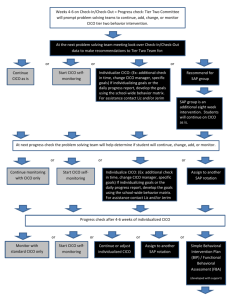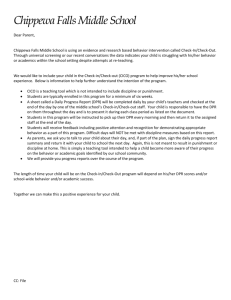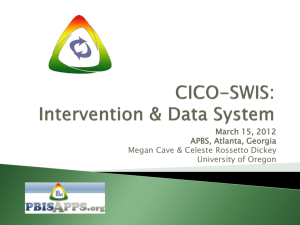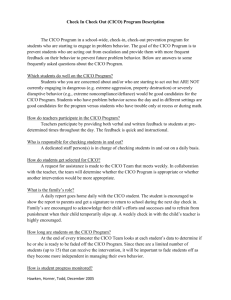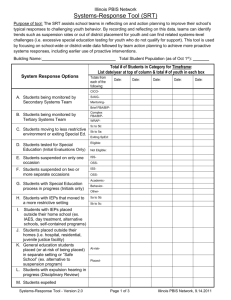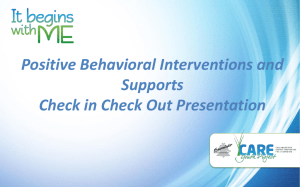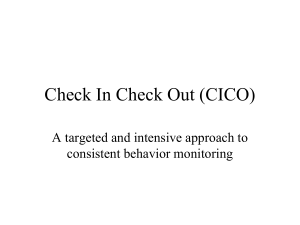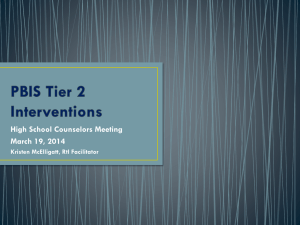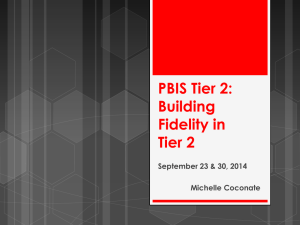BEP-CICO
advertisement
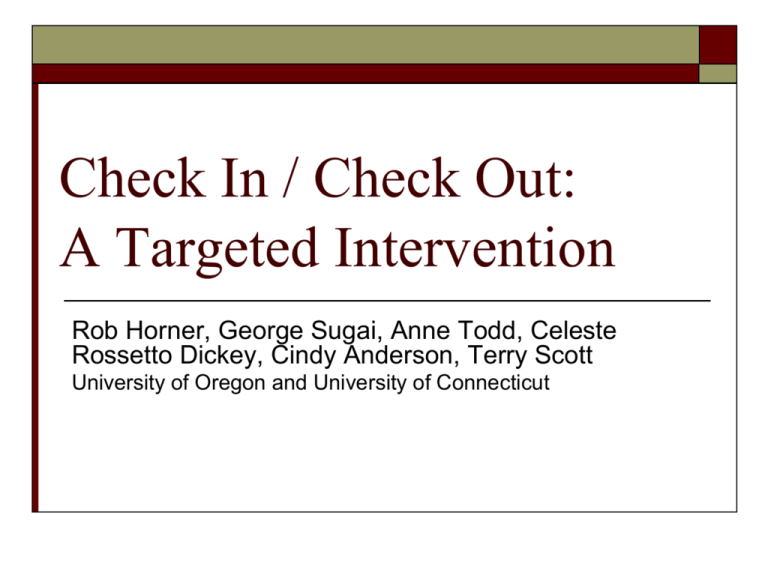
Check In / Check Out: A Targeted Intervention Rob Horner, George Sugai, Anne Todd, Celeste Rossetto Dickey, Cindy Anderson, Terry Scott University of Oregon and University of Connecticut Goals Define the logic and core features of Targeted Interventions, and the specifics of the Checkin/Check-out (CICO) approach. Provide empirical evidence supporting CICO, and practical examples from local schools. Self-assess if CICO is appropriate for your school Build action plan for CICO implementation CICO within School-wide PBS All specialized interventions are more effective, and more durable, if they are done with school-wide behavioral expectations as a foundation. SCHOOL-WIDE POSITIVE BEHAVIOR SUPPORT ~5% ~15% Tertiary Prevention: Specialized Individualized *Systems for Students with High-Risk Behavior Secondary Prevention: Targeted Interventions *Systems for Students with At-Risk Behavior Primary Prevention: School-/ClassroomWide Systems for All Students, Staff, & Settings ~80% of Students Major Features of Targeted Interventions Intervention is continuously available Rapid access to intervention (72 hr) Very low effort by teachers Consistent with school-wide expectations Implemented by all staff/faculty in a school Home/school linkage Flexible intervention based on assessment Functional Assessment Adequate resources (admin, team) weekly meeting, plus 10 hours a week for coordination Student chooses to participate Continuous monitoring for decision-making BEP/Check-in Check-out Cycle BEP Plan Morning Check-In Weekly BEP Meeting Class Check out 9 Week Graph Sent Teacher Checks Home Check-In Program Update Class Check in Afternoon Check-out EXIT CICO Record Name: ____________________________ 0 = Need work, 1 = “OK” 2 = Nice Job Date: ______________ Safe Responsible Respectful Check In 0 1 2 0 1 2 0 1 2 Before Recess 0 1 2 0 1 2 0 1 2 Before Lunch 0 1 2 0 1 2 0 1 2 After Recess 0 1 2 0 1 2 0 1 2 Check Out 0 1 2 0 1 2 0 1 2 Today’s goal Comments: Today’s total points HAWK Report Student _______________Teacher___________________ Date ________ Be Safe 0 = Not Yet 1= Good 2= Excellent Be Respectful Keep hands, feet, and objects to self Be Your Personal Best Teacher initials Use kind words and actions Follow directions Class 0 1 2 0 1 2 0 1 2 Recess 0 1 2 0 1 2 0 1 2 Class 0 1 2 0 1 2 0 1 2 Lunch 0 1 2 0 1 2 0 1 2 Class 0 1 2 0 1 2 0 1 2 Recess 0 1 2 0 1 2 0 1 2 Class 0 1 2 0 1 2 0 1 2 Total Points = Points Possible = Today ______________% 50 Working in class 0 1 2 0 1 2 0 1 2 0 1 2 Goal ______________% Daily Progress Report 1/5 Goals 2/6 3/7 HR 4/8 Be respectful 0 1 2 0 1 2 0 1 2 0 1 2 0 1 2 Be responsible 0 1 2 0 1 2 0 1 2 0 1 2 0 1 2 Keep Hand & Feet to Self 0 1 2 0 1 2 0 1 2 0 1 2 0 1 2 Follow Directions 0 1 2 0 1 2 0 1 2 0 1 2 0 1 2 Be There – Be Ready 1 2 0 1 2 0 1 2 0 1 2 0 1 2 TOTAL POINTS 0 Why does CICO work? Improved structure Student is “set up for success” Prompts are provided throughout the day for correct behavior. System for linking student with at least one positive adult. Student chooses to participate. First contact each morning is positive. “Blow-out” days are pre-empted. First contact each class period (or activity period) is positive, and sets up successful behavioral momentum. Increase in contingent feedback Feedback occurs more often. Feedback is tied to student behavior. Inappropriate behavior is less likely to be ignored or rewarded. Why does CICO Work? Program can be applied in all school locations Elevated reward for appropriate behavior For academic-based, escape-maintained problem behavior incorporate academic support Linking school and home support Adult and peer attention delivered each target period Adult attention (and tangible) delivered at end of day Linking behavior support and academic support Classroom, playground, cafeteria (anywhere there is a supervisor) Provide format for positive student/parent contact Program is organized to morph into a self-management system Increased options for making choices Increased ability to self-monitor performance/progress Logistics for Setting up a CICO program Faculty and staff commitment Is problem behavior a major concern? Are staff willing to commit 5 min per day? Is CICO a reasonable option for us? More than 5 students need extra support CICO is designed to work with 10-12% of kids in a school CICO typically “works” with 67% of students. CICO does NOT replace need for individualized supports. Team available Team leader CICO coordinator (morning, afternoon) Team (meets at least once every two weeks) Logistics for Setting up a CICO program School-wide PBS in place School-wide expectations defined and taught Reward system operating Clear and consistent consequences for problem behavior Process for identifying a student who may be appropriate for CICO Student is not responding to SWPBS expectations Request for Assistance Student finds adult attention rewarding Student is NOT in crisis. Logistics for Setting up a CICO program Daily CICO progress report card Same expectations for all Common schedule All staff taught rules for accepting, completing and returning the card. Home report process Can be same as progress card Can be a unique reporting form CICO Home Report Name: _____________________________ Date: _____________ ______ I met my goal today ______ I had a hard day One thing I did really well today was:_______________________ Something I will work on tomorrow is: _______________________ Comments: Parent/Guardian Signature: ________________________________________________________ Comments: Logistics for Setting up a CICO program Trading menu Reward for collecting and turning in daily progress card Reward for meeting daily goal Exchange system for points earned Collecting, summarizing and using data Daily updates Weekly review by team Referral to BISCC structure for individualized interventions. 28 CICO daily points Chad 100 80 % of possible pts % of possible pts CICO points earned Trevor 60 40 20 0 1 3 5 7 9 11 13 15 17 19 21 23 25 days 100 80 60 40 20 0 1 2 3 4 5 6 7 days 8 9 10 11 12 13 o f P o in ts Daily Data Used for Decision Making Ryan's BEP Performance 2000-2001 P e rc e n ta g e 100 80 60 40 20 0 03/07 03/08 03/09 03/12 Date 03/13 03/14 P e r c e n t a g e o f P o in t s Daily Data Used for Decision Making Rachelle's BEP Performance 2000-2001 100 80 60 40 20 0 02/05 02/08 02/13 Date 02/20 02/23 Building the Basic Cycles Morning Check-in Routine Teaching students when, when, how Teaching check-in coordinator Assess Reward Set-up or Redirect Teacher Check-in/Check-out Routine Teach students when, when, how Teaching staff/faculty Reward Set-up for success, positive momentum Evaluation Building the Basic Cycles Afternoon Check-out Routine Teach students when, where, how Teach CICO coordinator data collection, acknowledge success, encourage improvement. Consider self-recording system for older students Family Review Routine Teach students when, where, how Teach family only to acknowledge success, sign Building the Basic Cycles Trading Menu/ Process Reward for collecting and turning in daily progress report information Reward for meeting daily goal Exchange system for points earned? Building the advanced cycles Planning for success Moving from CICO to individualized behavior support. Functional behavioral assessment Comprehensive behavior support Substitute Teacher use of CICO How does student move off CICO? Adding self-management options to CICO How will substitutes learn about CICO routine? Extending CICO to playground, cafeteria, bus Linking CICO with Function-based support Leanne Hawken Robert March Anne Todd, Amy Kauffman Todd, Kauffman, Meyer & Horner 100 90 Baseline 80 Check-in Check-out 70 Trevor 60 50 40 Peer Composite 30 20 10 0 Percentage of Intervals with Problem Behavior 1 2 3 4 5 6 7 8 9 10 11 12 13 14 15 16 17 18 19 20 21 22 23 24 25 26 27 28 29 30 31 100 90 Chad 80 70 60 50 40 30 20 10 0 1 2 3 4 5 6 7 8 9 10 11 12 13 14 15 16 17 18 19 20 21 22 23 24 25 26 27 28 29 30 31 100 90 Kendall 80 70 60 50 40 30 20 10 0 1 2 3 4 5 6 7 8 9 10 11 12 13 14 15 16 17 18 19 20 21 22 23 24 25 26 27 28 29 30 31 100 90 Eric 80 70 60 50 40 30 20 10 0 1 2 3 4 5 6 7 8 9 10 11 12 13 14 15 16 17 18 19 20 21 22 23 24 25 26 27 28 29 30 31 Plan for the future: We want self-managers Embed self-management strategies as driven by the data Use natural signals for monitoring as much as possible Self-monitor Self-record, check for accuracy Fewer check points during the day Maintain AM and PM times for awhile Manage own CICO account More on self management in the future….. Check-in Check-out Embedded Within SWIS Check-in Check-out Embedded Within SWIS Check-in Check-out Embedded Within SWIS Check-in/ Check-out Self-Assessment Individually score the elements of the CICO SelfAssessment In place; In progress; Not in place As a team review your ratings, and agree on a single summary for the school For elements not scored as “in place” define the actions that will move you toward implementation. Who will do what, when? Define a schedule for meeting to review progress and implement your CICO plan. Assessing of CICO is right for your school What do Targeted Interventions do? Increase access to adult attention Increase access to peer attention Increase access to activity choice Acceptable options for avoiding aversive activities Acceptable options for avoiding aversive social Increased structure (prompts for approp behavior) Structured times for feedback (5 per day) Enhanced home-school communication Development of self-management skills CICO Self-Assess Summary Targeted interventions CICO is one option Highly Efficient, structured support Assess for whom it will work Enlist whole faculty involvement CICO will still need supplement from Tertiary, Function-based support system
